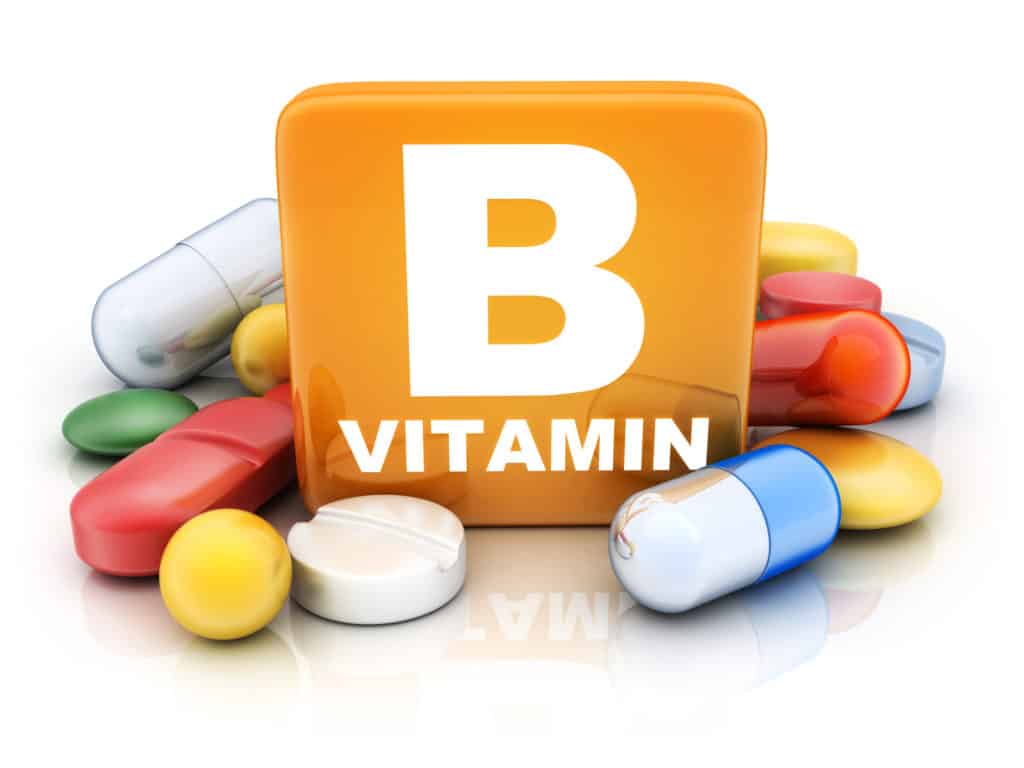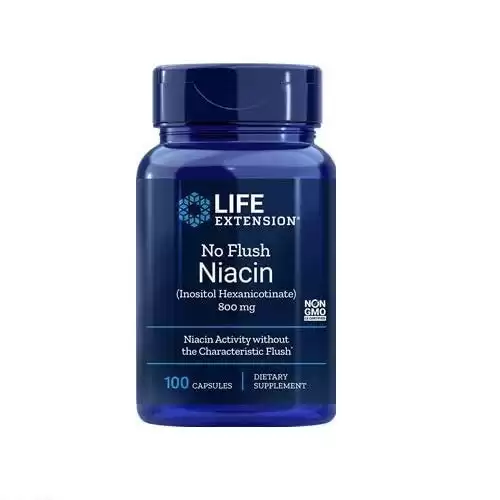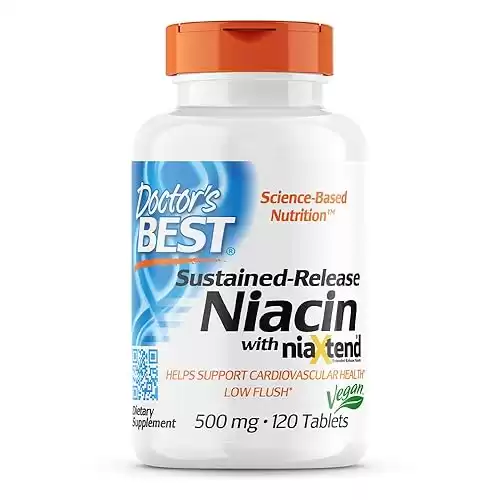The Ultimate Guide of Niacin Benefits, Side Effects & Supplementation
Niacin, also known as nicotinic acid, is an important vitamin for the body. It can be used to treat high cholesterol levels and prevent heart disease. Niacin has other benefits that are less well researched but still worth considering. Niacin comes with some side effects though including dry skin, water retention, and a flush reaction which causes redness of the face and neck. Read on to learn more about niacin benefits, side effects & supplementation!

Table of Contents
What is Niacin?
It is vitamin B3, nicotinic acid, or nicotinamide. It is the precursor to nicotinamide adenine dinucleotide (NAD) and nicotinamide adenine dinucleotide phosphate (NADP) which are antioxidants that are important for respiration and cellular metabolism. Niacin, NAD, and NADP have been shown to slow the process of aging, cancer treatment, metabolic and cardiovascular diseases. (Kirkland & Meyer-Ficca, 2018)
What does niacin do to the body?
Niacin is used to treat high cholesterol levels and prevent heart disease. It does this by reducing the bad cholesterol (LDL) in the blood while increasing the good cholesterol(HDL). Niacin can also help to keep arteries open and improve blood flow. This makes it an important treatment for people with heart disease or those at risk of developing it. There is a niacin flush that causes the body to release histamines. This causes the blood vessels to dilate and can lead to a feeling of warmth or flushing in the face and neck. (Mayo Clinic, n.d.)
Niacin Flush
The niacin flush is a side effect of taking niacin that can cause the face and neck to become red and warm. Niacin causes prostaglandin synthesis, vasodilatation, and skin flushing, which happens when the body releases histamines in response to the niacin. (Nadalin et. al., 2010)
What is flush-free niacin?
Flush-free niacin does not cause a flush reaction. It is made by adding nicotinamide to regular niacin which reduces the number of histamines released in response to taking it. However, the flush may be uncomfortable, but it is recommended to avoid the flush-free niacin, because the benefits can be lessened, including the improvement of blood flow.
- Life Extension - No Flush Niacin - 800 Mg - 100 Caps (2-Pack)
- Doctor's Best TimeRelease Niacin with niaxtend NonGMO Vegan Gluten Free 500 mg Tablets, 120 Count

No Flush Niacin offers all the benefits people get in niacin supplements: metabolism health, cardiovascular and neurological support. However, it doesn’t cause the flushing many people experience.
We earn a commission if you make a purchase, at no additional cost to you.

Real Niacin provides niacin in an 8-hour extended-release form that enables you to enjoy the health benefits of niacin without experiencing the uncomfortable skin flushing that commonly accompanies other forms of niacin.
Niacin, also known as vitamin B3 or nicotinic acid, supports more than 500 enzymatic reactions that play pivotal roles in metabolism, energy production, and healthy aging
We earn a commission if you make a purchase, at no additional cost to you.
How long does a niacin flush last?
The flush usually lasts for about 30 minutes after taking the niacin and will go away on its own. There are some things that you can do to help reduce or prevent the flush reaction including starting with a low dose of niacin, taking it with food, and avoiding hot drinks or spicy foods. (Mayo Clinic, n.d.)
You could also take it before bedtime if you fall asleep quickly or when you know you are tired enough to fall asleep relatively soon. This can help you avoid feeling the flush, but still, get the benefits of the flush.
When should you take niacin?
It’s best to take it before bed as I mentioned or if you feel like the possibility of feeling a flush may cause you to stay awake, then take it around lunchtime. Take it with a meal and make sure you had breakfast that way you have two meals in your system and this will minimize the flush.
Niacin Deficiency Effects
- Pellagra (read down below)
- Poor Nerve Function
- High Triglycerides
- Skin inflammation
- Atherosclerosis
Niacin Side Effects
There are some other side effects that can occur when taking niacin including dry skin, water retention, and an upset stomach. These side effects are less common but still worth mentioning.
If you are experiencing any of these niacin side effects then it is best to speak with your doctor or pharmacist about the options for treatment. (Mayo Clinic, n.d.) The most common side effects associated with using niacin are dry skin, water retention, and a flushing reaction that causes redness of the face and neck.
Nausea, vomiting or stomach discomfort may also be experienced while taking higher doses (500mg) on an empty stomach.
These side effects can usually be reduced by starting with a low dose of 50-100mg per day for several weeks before increasing your dosage if needed. Taking niacin after eating food will reduce these side effects as
Niacin Supplementation
It is possible to get enough niacin through diet alone if you eat a lot of meat and fish including tuna, salmon, peanuts, and liver. You can find a list of foods high in niacin in this article.
However, most people will benefit from supplementation especially those who have had their gallbladder removed since they cannot secrete bile which helps break down some types of dietary fats. (Kirkland & Meyer-Ficca, 2018)
How do I take my Niacin?
It can be taken in capsule form in a flush-free or flush version, depending on your tolerance. You can take it for anxiety and depression in addition to the many heart benefits it has.
Take it before bed or in the middle of your meal so you have some food in your system and then more afterward to slow the flush.
A great way to keep track of what you are thankful for and focus on all the good you have in your life.
What are some other niacin benefits?
There is evidence that niacin has other benefits that are less well researched but still worth considering. These include:
– improved pancreatic function in people with diabetes
– improved nerve function in people with diabetes
– reduced symptoms of schizophrenia
– better skin appearance, especially in those with acne
– improved cognitive function (memory & thinking skills) in older adults
More About Niacin Benefits
1. Cholesterol
Niacin has anti-inflammatory effects which are important for heart health and artery blockage. Niacin works by blocking (hepatic diacylglycerol acyltransferase 2) the enzyme that produces triglycerides. (Meyers et. al., 2004)
Niacin has shown to be very effective in minimizing triglycerides by lowering them by 35% and LDL cholesterol by 15%, it also raised HDL “good cholesterol” by 25%.
2. Skincare
Niacinamide or niacin has a stabilizing effect on epidermal barrier function, it smooths out wrinkles, improves the surface structure and its anti-inflammatory effects can minimize acne and rosacea.
Niacinamide works well to improve discoloration of the skin and improve its moisture.
3. Memory
Niacin is a precursor for NAD+ and NAD has been shown to restore mitochondrial function and reverse cognitive decline. It also can lengthen a lifespan, especially from a cognitive perspective.
Its antioxidant benefits are very helpful for memory and cognitive function. Also, it helps to reduce the effects of inflammation which contributes to depression, anxiety, and other cognitive disorders.
4. Pellagra
Pellagra is caused by a niacin deficiency, certain medications, and alcoholism. Pellagra causes weakness, confusion, dermatitis, diarrhea, and dementia.
Dermatitis caused by pellagra looks like a sunburn at first and then progresses to skin eruptions and burning. Pellagra can occur from anorexia or malabsorptive diarrhea and pellagra actually contribute to the individual’s struggle with anorexia.
Neuropsychological effects include delusions, hallucinations, memory loss, psychosis, and depression. (Pitche, 2005)
5. Antidepressant
These are maybe lesser well-known niacin benefits compared to its typical use for cholesterol since niacin used to be used in drug forms for high cholesterol.
Multiple studies have shown that there were reportedly low levels of niacin in patients with schizophrenia. Serotonin is one of the neurotransmitters that are low in people who struggle with depression.
The kynurenine pathway (KP) is where the majority of metabolites contributing to mood disorders occur. KP activation suppresses serotonin neurotransmission, therefore suppressing the production of serotonin. High levels of kynurenic acid have been found in schizophrenic and bipolar patients postmortem.
The imbalance of KP can attribute to the feeling of a lack of pleasure (anhedonia) felt in individuals struggling with major depressive disorder (MDD).
Nicotinamide biosynthesis is done in the brain in very small amounts. (Gasperi et. al., 2019)
Niacin has been shown to have a natural antidepressant effect.
6.Cancer
Niacin or niacinamide has been shown to have apoptotic effects, which is the normal death of cells (this is not the case in cancer patients, the cells grow at rapid rates and do not die at a normal rate).
Can too much niacin cause liver damage?
Niacin has actually been shown to improve liver function in individuals who have non-alcoholic fatty liver disease (hepatic steatosis) which is commonly caused by type 2 diabetes and obesity. (Ganji et. al., 2014)
NAD Benefits
NAD+ is shown to be cardioprotective, and it regulates DNA damage responses and calcium signaling. (Matasic et. al., 2018) NAD has also been researched and shown to rejuvenate the quality of oocytes which are required for fertility. By rejuvenating these oocytes, mammals are able to restore fertility.
As you can see the niacin flush is definitely outweighed by its very long list of benefits! In summary, niacin or niacinamide is very beneficial for cognitive function, memory, many mood disorders, heart, and brain health.
References:
Ganji, S. H., Kukes, G. D., Lambrecht, N., Kashyap, M. L., & Kamanna, V. S. (2014). Therapeutic role of niacin in the prevention and regression of hepatic steatosis in rat model of nonalcoholic fatty liver disease. American journal of physiology. Gastrointestinal and liver physiology, 306(4), G320–G327. https://doi.org/10.1152/ajpgi.00181.2013
Gasperi, V., Sibilano, M., Savini, I., & Catani, M. V. (2019). Niacin in the Central Nervous System: An Update of Biological Aspects and Clinical Applications. International journal of molecular sciences, 20(4), 974. https://doi.org/10.3390/ijms20040974
Kirkland, J. B., & Meyer-Ficca, M. L. (2018). Niacin. Advances in food and nutrition research, 83, 83–149. https://doi.org/10.1016/bs.afnr.2017.11.003
Nadalin, S., Bureti?-Tomljanovi?, A., Rubesa, G., Tomljanovi?, D., & Gudelj, L. (2010). Niacin skin flush test: a research tool for studying schizophrenia. Psychiatria Danubina, 22(1), 14–27.
Matasic, D. S., Brenner, C., & London, B. (2018). Emerging potential benefits of modulating NAD+ metabolism in cardiovascular disease. American journal of physiology. Heart and circulatory physiology, 314(4), H839–H852. https://doi.org/10.1152/ajpheart.00409.2017
Meyers, C. D., Kamanna, V. S., & Kashyap, M. L. (2004). Niacin therapy in atherosclerosis. Current opinion in lipidology, 15(6), 659–665. https://doi.org/10.1097/00041433-200412000-00006
Pitche P. T. (2005). Pellagre et érythèmes pellagroïdes [Pellagra]. Sante (Montrouge, France), 15(3), 205–208.
Originally posted 2021-12-13 18:03:31.
Megan Santiago
Latest posts by Megan Santiago (see all)
- How to Find a Trauma Therapist in Tampa - September 30, 2024
- Get Your Child to Listen: A Clear-Cut Way To Feel Heard - March 10, 2024
- Help With Bills – How to Get Financial Assistance - March 10, 2024

